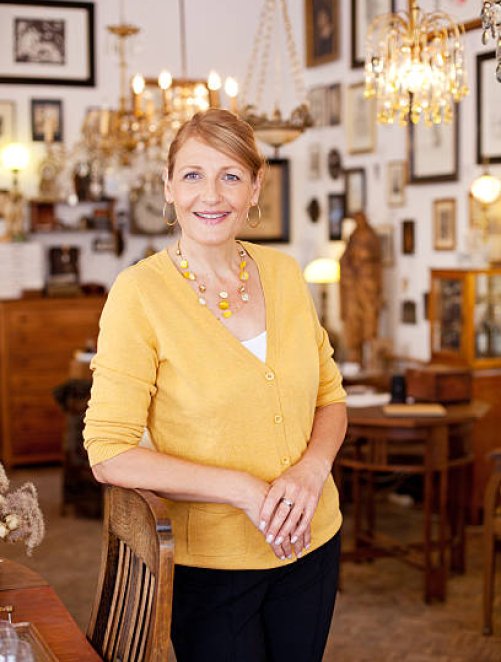Villeroy-Boch Vase, Tan and Blue Flower Motif 6.5diax16.5
Maker/Artist: Villeroy-Boch, Mettlach, Mark: on bottom, V&B M in a circle, Made in Saar-Basin, #2506 26 Style/Era: 1913-1947, Mettlach, German, Art Nouveau Dimensions: 6.5""dia x 16.5"" H Description: The vase stands on a rounded pedestal foot with the rounded body applied in relief with band of floral designs with panels containing stylised floral designs with small raised florets applied to a textured ground. The vase is decorated in bright and matted coloured glazes and has a narrow wide rounded opening Biography/Maker Information: Francois Boch bears the title ""Bombardier du Roi"", royal cannon founder. The iron founder from village of Audun-le-Tiche in Lorraine, however, decides to start a new career. In 1748, together with his three sons, he begins manufacturing ceramic crockery. This marks the birth of the Villeroy & Boch company. Luxembourg is one of the Bochs' initial sales markets. Due to this fact Francois' son, Pierre-Joseph, submits a request to the Austrian government for permission to set up a manufactory in the Province of Luxembourg. Of the numerous persons who apply, he receives authorisation from Empress Maria Theresia. The new factory at Septfontaines/Luxembourg is also a major step from manufactory operations to early industrial serial production. As a sign of special recognition, the Faiencerie is permitted to call itself Manufacture Impériale et Royale. Popular around the world, the Alt Luxemburg crockery series is a Villeroy & Boch evergreen. It dates back to the Brindille pattern which was introduced by Pierre-Joseph in 1770. The creatively gifted entrepreneur fashioned a series of artistic ceramic items including a rocaille hanging flowerpot and a crucifix base with snake symbol – both exhibits can to be found in the Mettlach Ceramics Museum. Together with two partners, the businessman Nicolas Villeroy acquires an earthenware factory in Vaudrevange, which is today called Wallerfangen. In 1797 he becomes its sole owner. Villeroy is one of the first ceramics manufacturers to use coal as fuel. He calls in specialists from England and France to modernise production. Above all, he experiments with pattern printing. From 1815 he applies the copper printing process which enables products to be offered more cheaply. As an entrepreneur Pierre-Joseph is one of the social pioneers of the early 19th century. He founds the social institution Antonius Guild in Septfontaines. Its fundamental elements are insurance to cover illness, accidents, and disability, and also a pension fund. It is a comprehensive social insurance to which both employees and the company pay contributions. Antonius Guild benefits are considerably more extensive than those which later became law. They serve as a model for Bismarck 70 years later when he develops the first German social insurance scheme. In 1857, Nicolas Villeroy's daughter Leonie and her husband Adolphe de Galhau set up the Sophie Trust to support families in need. While the second Boch generation achieved an optimised product quality by experimenting with materials, the third generation made a decisive leap with Jean-Francois Boch. Trained at the École de Sciences in Paris, the entrepreneur successfully develops a type of earthenware which is bright white and extremely hard. It looks deceptively like porcelain, but could be supplied considerably cheaper. This path democratised tableware. As a result of this early innovation, porcelain – the previously rare and costly, precious treasure reserved solely for the nobility – if now affordable for broad classes of society. The products are not only well-accepted on the market, but also officially. At the first Prussian trade exhibition in Berlin in 1822, the Bochs receive the gold medal, which is followed by many national and international awards. The factories of the entrepreneurs Boch and Villeroy are not far away from each other. Now and again the two competitors, who successfully market their products beyond Germany's borders, even meet. But in order to exist in Europe's economic framework, particularly alongside the dominant English industry, the two agree to merge. Villeroy & Boch is born. It combines the strengths of both sides: creative talent, entrepreneurial spirit, innovative power and production capacity, and is one of the 19th century's first global players
unknown
Other
Yes


Hi Abigail,
Thank you for contacting Mearto with your appraisal inquiry.
Based on the photos and information provided, and subject to examination, this is:
A vintage Art Nouveau style Villeroy & Boch Mettlach earthenware vase
Made in Saar-Basin, Germany, circa first quarter 20th Century
model #2506 26, the tan body with enameled floral decoration and decorative banding, marked below.
16 1/2 inches by 6 1/2 inches diameter
CONDITION: not examined in person but appears to be in good condition
$300-500*
*represents a fair-market value for auction purposes; retail or asking price may vary.
Please let us know if you have additional items to appraise, and thank you again for using Mearto.







